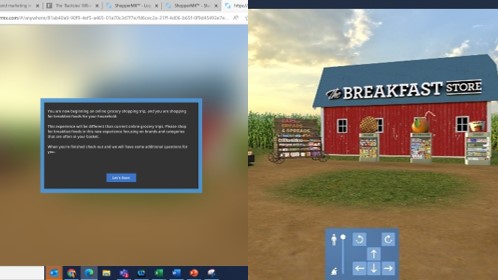It could be said that 2022 was the year of Metaverse. After Mark Zuckerberg changed Facebook’s name to Meta in October 2021, we saw a lot of conversation around metaverse(s) and what they could mean for the future of how we live, work and socialize. However, in recent months, conversations have transitioned to focus on AI; dialogue around metaverse is much more subdued. Companies are pulling back investment, ChatGPT has become the next big thing, and we’ve landed at an interesting point of stability. So what happened to all the metaverse hype?
Interest in metaverse hasn’t disappeared, it’s just being redirected to more actionable use cases that can be capitalized on today. A quick Google trends analysis illustrates that searches on “metaverse” have leveled out and now look relatively consistent with virtual reality (VR), a critical element of metaverse experiences that is highly prevalent in everyday life today. In fact, we predict that practical applications for metaverse experiences will continue to evolve and gain traction, though quietly, driven by commercial uses.
So, what are some practical applications for metaverse experiences today in the commercial world? They’ve been around for quite some time, so none of this is new. But they are becoming more and more relevant and ubiquitous in everyday life.
- Brand Marketing and Awareness: The role of metaverse and extended reality experiences in marketing are just starting to take off. A recent article in the Wall Street Journal specifically touched on the role of Metaverse experiences for brand marketing. It focused on opportunities in highly penetrated metaverses today: Roblox, Fortnight, and Decentraland—yet there are many more opportunities out there today when it comes to the broader opportunity of extended reality. It’s hard to isolate best-in-class given the breadth of sponsorships, events, and games within these platforms, but brands like Coca-Cola, Nike, Hyundai and even Gucci are doing interesting things. Metaverse experiences will continue to be a path for brands to gain exposure to new audiences, create buzz among current consumers, and drive brand awareness and engagement.
- Concept Visualization and Ideation: With 3D content available—or at least relatively easy to create—virtual reality platforms allow you to not only bring ideas to life, but to iterate on them at no incremental cost but the software. InContext clients build out in-store shopper marketing and display ideas, create and evolve new store concepts or footprints, and can visualize complex physical products and displays in 3D before moving to production. With the technology that exists today, companies shouldn’t be sending millions to new cars, new homes, or new vacuums without ensuring the digital twin has been optimized.
- Planning and Strategy: Taking it one step further, companies, communities, and other organizations have relied on VR or augmented reality (AR) tools for planning purposes for years. From something as simple as modeling new products, planograms, or stores in 3D, to mapping out cities and transportation systems and supply chains, these tools have become a critical part of strategic planning for many companies trying to navigate the best decisions to make to optimize their business’ bottom line. VR or AR tools allow people to take foundational ideas and layer on multiple layers of data, model out various scenarios and observe the predicted impact in real time.
- Training and Development: Once concepts are modeled and optimized virtually, companies can utilize those created experiences in several different ways. Some companies design virtual experiences that recreate real-life scenarios and then allow their employees to train within the virtual (or metaverse) environment. It’s much safer and more cost-effective for employees to make mistakes in a simulation rather than in real life. Pilots and other navigators have been trained in virtual simulators for years, and now we see it becoming a standard practice in other high-profile industries: medicine, law enforcement, manufacturing, retail, and athletics. The opportunity here is only going to evolve as AI provides the opportunity to adjust scenarios in real-time, and gaming platforms with multi-player functionality allow organizations to train people cross-functionally, interactively, from multiple locations.
- Test and Learn: Another way companies can optimize the scenarios built in extended reality today is through testing the idea with clients or consumers. Virtual reality testing has been around for well over a decade, and it has been utilized across research companies to tests millions of ideas. Every company (or client) may take a different approach, but the core benefit is allowing the end user to provide real input, both attitudinally and behaviorally, in what they like about an idea and what could improve. This has become an embedded element in store concept testing, new product testing, packaging and shelf testing, and opportunities and capabilities will continue to evolve.Historically, this has been a quantitative method of research testing, with the goal of ensuring predictive analytics; however, post-Covid, we have seen it become a cost-effective means to test national and international audiences as an evolved version of shop-a-longs, one-on-one interviews and even focus groups. There is significant cost savings in using behavioral-based virtual reality testing, and it serves as a quantifiable way to predict performance and minimize risk for both retailers and manufacturers.
- Concept Execution and Compliance: If you have ideated and tested your ideas in extended reality, the clear next step is to utilize those assets to ensure the concepts are executed accurately in the physical world. Today, you can take 3D modeled displays and planograms and confirm that they fit and will look great in the physical store with the help of AR technology. Soon field reps will be using computer vision solutions to check for planogram accuracy, track out-of-stocks, and recommend alternatives to fill gaps on the shelf, with AR as the foundation vehicle to communicate back to employees, retail staff, and even consumers. This space is just starting to take off, but it will be a critical toolkit for sales teams and retail operations in the coming years.

- Virtual Commerce: For several years, brands have been experimenting with the concept of virtual shopping experiences. They provide an extended brand experience that is more immersive and interactive than the classic e-commerce platform, and serve as a complement to the way shoppers currently shop online today. Experiences so far are limited, offering curated assortment, limited interactivity, and simple executions. While they create buzz, they might not be driving commercial value yet. This is one place where we see gamified executions or retail evolving and becoming a clear path for brand differentiation and increased profitability online in the coming years. Imagine playing trivia or a game while purchasing your breakfast items for the week. You could shop for your fruits and vegetables “directly” at the virtual farm store, picking the apples from the tree or your watermelon from the patch with details about where the items were grown and how long it’s been since they’ve been harvested. As technology evolves, you could shop for beauty products using an avatar that tests products out virtually with your friends joining you and staff making recommendations to you while sitting on your couch on your tablet. Virtual (and meta) commerce may be the furthest out from majority adoption, but it could be the one extended reality experience that evolves how we shop and engage in the future.
Are you exploring how your company can utilize extended reality or metaverse experiences to drive your business? Let us help you! Contact us to learn more and to discuss how to start building your extended reality and metaverse commercial roadmap.
This post was written by Diana Sheehan, Principal – Consulting Services



